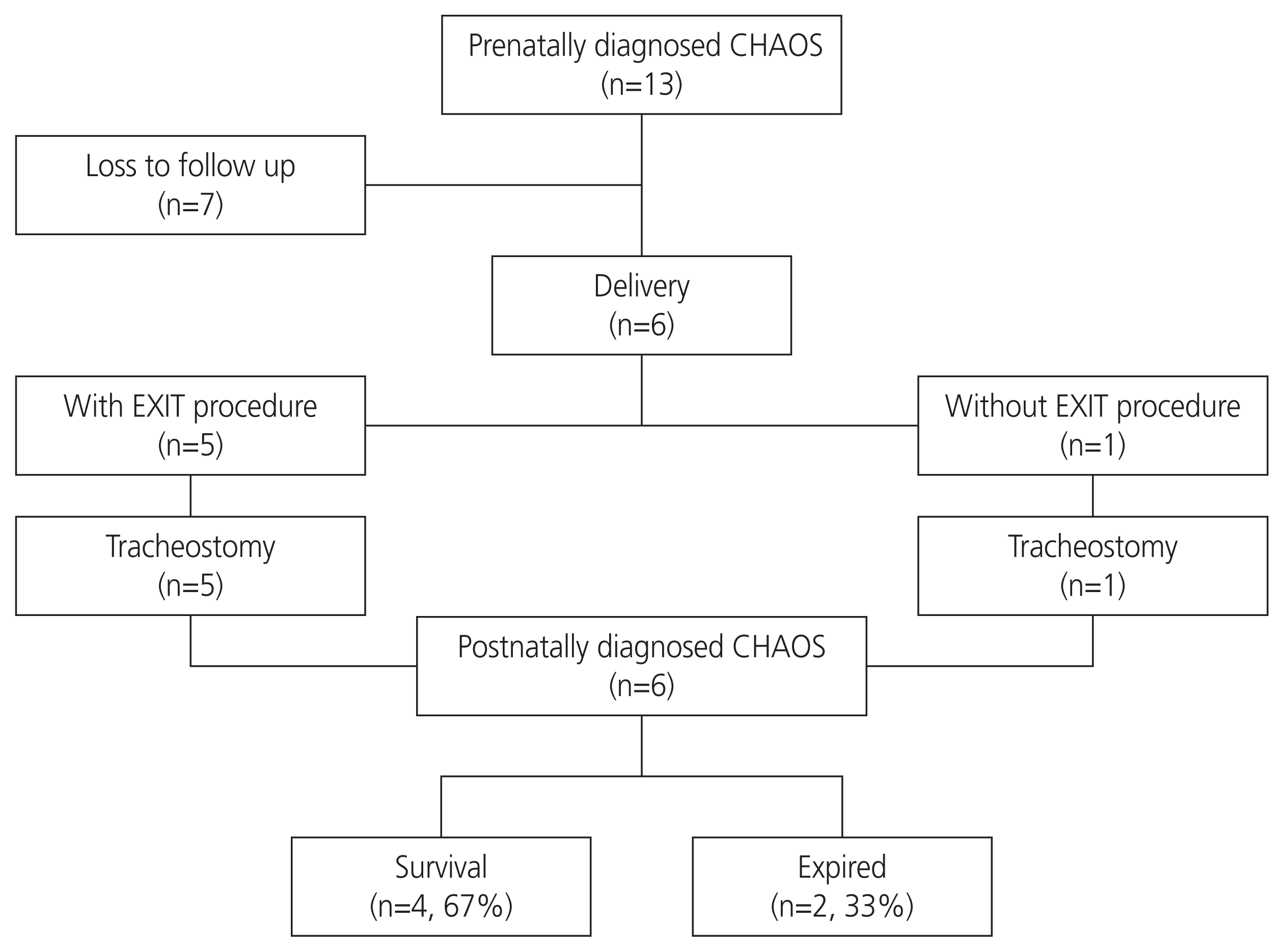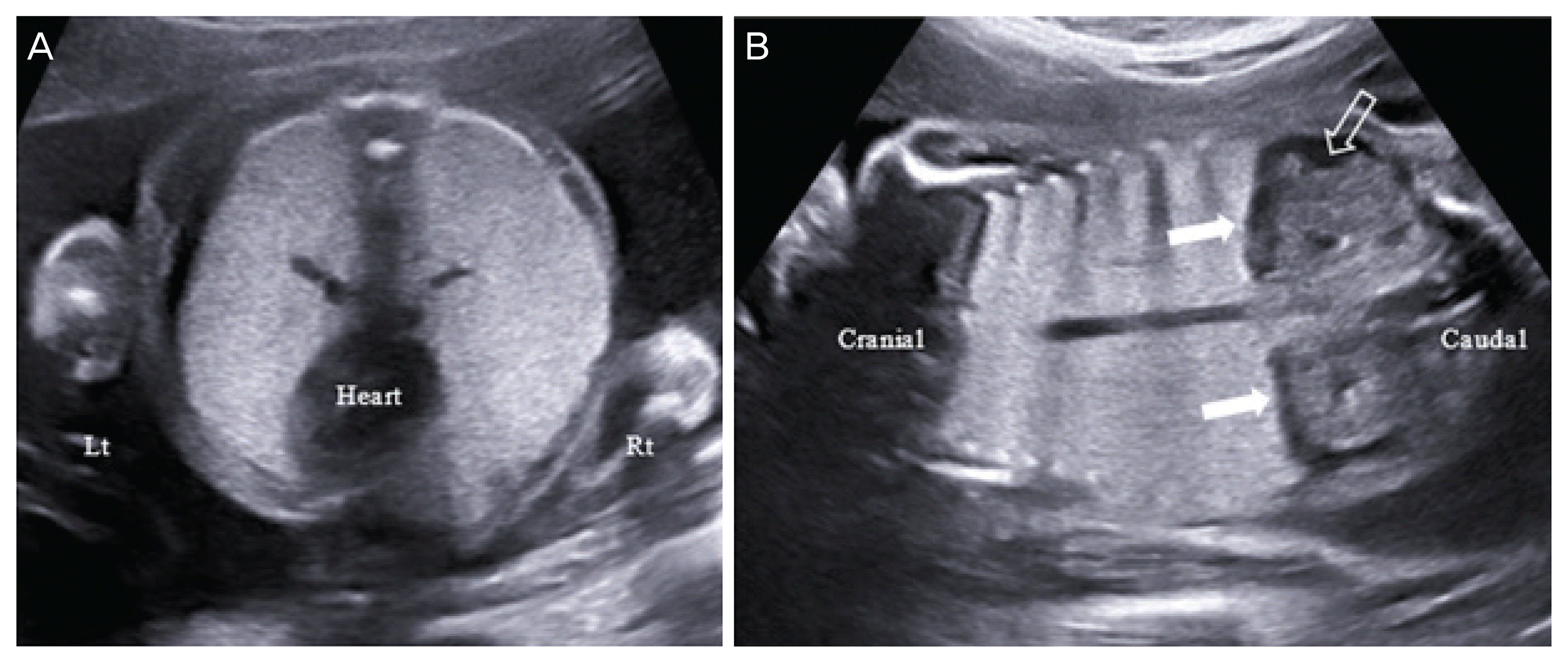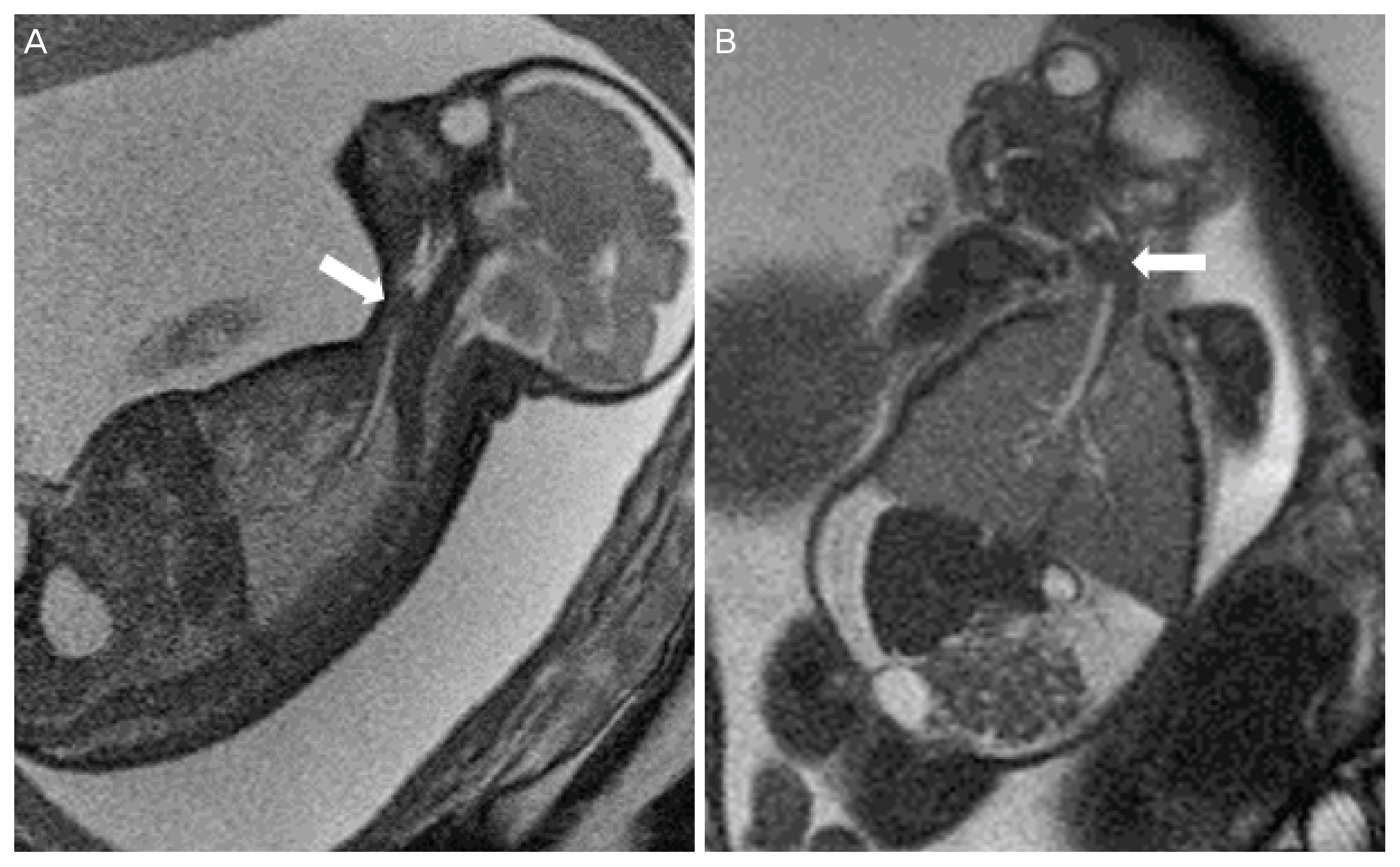1. Hedrick MH, Ferro MM, Filly RA, Flake AW, Harrison MR, Adzick NS. Congenital high airway obstruction syndrome (CHAOS): a potential for perinatal intervention. J Pediatr Surg. 1994; 29:271–4.


2. Lim FY, Crombleholme TM, Hedrick HL, Flake AW, Johnson MP, Howell LJ, et al. Congenital high airway obstruction syndrome: natural history and management. J Pediatr Surg. 2003; 38:940–5.


3. Oepkes D, Teunissen AK, Van De Velde M, Devlieger H, Delaere P, Deprest J. Congenital high airway obstruction syndrome successfully managed with ex-utero intrapartum treatment. Ultrasound Obstet Gynecol. 2003; 22:437–9.


5. Hirose S, Farmer DL, Lee H, Nobuhara KK, Harrison MR. The ex utero intrapartum treatment procedure: Looking back at the EXIT. J Pediatr Surg. 2004; 39:375–80.


6. Paek BW, Callen PW, Kitterman J, Feldstein VA, Farrell J, Harrison MR, et al. Successful fetal intervention for congenital high airway obstruction syndrome. Fetal Diagn Ther. 2002; 17:272–6.


7. Bouchard S, Johnson MP, Flake AW, Howell LJ, Myers LB, Adzick NS, et al. The EXIT procedure: experience and outcome in 31 cases. J Pediatr Surg. 2002; 37:418–26.


8. Crombleholme TM, Sylvester K, Flake AW, Adzick NS. Salvage of a fetus with congenital high airway obstruction syndrome by ex utero intrapartum treatment (EXIT) procedure. Fetal Diagn Ther. 2000; 15:280–2.


9. Bui TH, Grunewald C, Frenckner B, Kuylenstierna R, Dahlgren G, Edner A, et al. Successful EXIT (ex utero intrapartum treatment) procedure in a fetus diagnosed prenatally with congenital high-airway obstruction syndrome due to laryngeal atresia. Eur J Pediatr Surg. 2000; 10:328–33.


10. DeCou JM, Jones DC, Jacobs HD, Touloukian RJ. Successful ex utero intrapartum treatment (EXIT) procedure for congenital high airway obstruction syndrome (CHAOS) owing to laryngeal atresia. J Pediatr Surg. 1998; 33:1563–5.


11. Roybal JL, Liechty KW, Hedrick HL, Bebbington MW, Johnson MP, Coleman BG, et al. Predicting the severity of congenital high airway obstruction syndrome. J Pediatr Surg. 2010; 45:1633–9.


12. Saadai P, Jelin EB, Nijagal A, Schecter SC, Hirose S, MacKenzie TC, et al. Long-term outcomes after fetal therapy for congenital high airway obstructive syndrome. J Pediatr Surg. 2012; 47:1095–100.


13. Nolan HR, Gurria J, Peiro JL, Tabbah S, Diaz-Primera R, Polzin W, et al. Congenital high airway obstruction syndrome (CHAOS): Natural history, prenatal management strategies, and outcomes at a single comprehensive fetal center. J Pediatr Surg. 2019; 54:1153–8.


14. Kuwashima S, Kitajima K, Kaji Y, Watanabe H, Watabe Y, Suzumura H. MR imaging appearance of laryngeal atresia (congenital high airway obstruction syndrome): unique course in a fetus. Pediatr Radiol. 2008; 38:344–7.


15. Furukawa R, Aihara T, Tazuke Y, Maeda K, Kuwata T. Congenital high airway obstruction syndrome without tracheoesophageal fistula and with in utero decrease in relative lung size. Pediatr Radiol. 2012; 42:1510–3.


16. Hartnick CJ, Rutter M, Lang F, Willging JP, Cotton RT. Congenital high airway obstruction syndrome and airway reconstruction: an evolving paradigm. Arch Otolaryngol Head Neck Surg. 2002; 128:567–70.

17. Shimabukuro F, Sakumoto K, Masamoto H, Asato Y, Yoshida T, Shinhama A, et al. A case of congenital high airway obstruction syndrome managed by ex utero intrapartum treatment: case report and review of the literature. Am J Perinatol. 2007; 24:197–201.


18. Colnaghi M, Condo V, Gagliardi L, Mirabile L, Fumagalli M, Mosca F. Prenatal diagnosis and postnatal management of congenital laryngeal atresia in a preterm infant. Ultrasound Obstet Gynecol. 2007; 29:583–5.


19. Mong A, Johnson AM, Kramer SS, Coleman BG, Hedrick HL, Kreiger P, et al. Congenital high airway obstruction syndrome: MR/US findings, effect on management, and outcome. Pediatr Radiol. 2008; 38:1171–9.


21. Elliott R, Vallera C, Heitmiller ES, Isaac G, Lee M, Crino J, et al. Ex utero intrapartum treatment procedure for management of congenital high airway obstruction syndrome in a vertex/breech twin gestation. Int J Pediatr Otorhinolaryngol. 2013; 77:439–42.


22. Barthod G, Teissier N, Bellarbi N, Viala P, Oury JF, Dray G, et al. Fetal airway management on placental support: limitations and ethical considerations in seven cases. J Obstet Gynaecol. 2013; 33:787–94.


23. Gonzales SK, Goudy S, Prickett K, Ellis J. EXIT (ex utero intrapartum treatment) in a growth restricted fetus with tracheal atresia. Int J Pediatr Otorhinolaryngol. 2018; 105:72–4.


24. Masahata K, Soh H, Tachibana K, Sasahara J, Hirose M, Yamanishi T, et al. Clinical outcomes of ex utero intrapartum treatment for fetal airway obstruction. Pediatr Surg Int. 2019; 35:835–43.







 PDF
PDF Citation
Citation Print
Print




 XML Download
XML Download